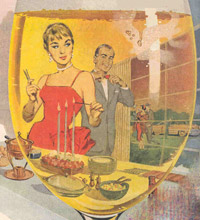 Here’s a multiple choice question:
Here’s a multiple choice question:
a) Beer is an industrial product.
b) Beer is an artisanal product.
c) Wine is a pastoral/agricultural product.
d) Wine is an industrial product.
Which if these choices do you think Field Maloney chose in a story that appeared the web magazine Slate? I’ll give you a hint. The headline read: Beer in the Headlights. Sales are flat. Wine is ascendant. How did this happen?
He wrote about a) and c). We know – and I’m pretty sure he does, too – that the correct answer is “all of the above.”
I’m hoping that Jay Brooks gets around to a complete critique of this story (looks like he did), because a beer guy can find a lot to object to – whether it is the way that he uses a genuine beer expert like Lew Bryson to add beer cred or the less-than-accurate description of how beer is made.
(Or the fact that he writes “A Google search of beer and passion yields 1.48 million entries, while wine and passion yields four times that.” When I did that a minute ago the numbers were 1.7 million and 2 million.)
Much of what Mr. Maloney writes is correct. The largest American breweries have an image problem, although projects like Anheuser-Busch’s Here’s to Beer may be helping. Connoisseurship, passion and lifestyle are increasingly important.
However, I’m not buying into the wine/hand-crafted and beer/industrial premise. Consider these facts:
– Two Buck Chuck, called Charles Shaw wines in better company but still selling for $1.99 in California and a bit more elsewhere, last year accounted for 5 million cases of sales in 274 Trader Joe’s across the country. In California, wine heaven, eight out of 100 bottles of all wine sold are Two Buck Chuck. So growth hasn’t been fueled only by the “fine-wine industry.”
– The ascendance of fine wine and fine dining is generally linked to Northern California in the 1970s. That’s when Alice Waters opened Chez Panisse in Berkeley and vintners from Napa and Sonoma scored their victories in the “Judgment of Paris.” It’s ALSO when Fritz Maytag modernized Anchor Brewing, effectively making it the first American microbrewery. Soon Jack McAuliffe founded New Albion Brewing, then Ken Grossman and Paul Camusi started Sierra Nevada, and we were off and running.
Last year the breweries we call craft produced comparable to 100 million cases – all less generic than Two Buck Chuck.
Hey, Slate, how did this happen?
Great minds think alike, my friend!
See my own response on Bar Stories (I kind of went off).
I have to say that the whole Google search thing was bizarre—after all his attempts at justifying his points with stats and industry insider quotes, he went and conducted his own ultra-scientific survey—very nice.
I think your last point is probably one of the most overlooked facts in all the beverage world: the fact is, flavor and craft—in any segment—are starting to pick up among consumers. People want to feel like they have a personal connection to the product they buy, and what better way to do that than buy from the artisan, the craftsman, the boutique winery/brewery?
If I’m wrong, then why is A-B putting out beer after beer under pseudonymous (is that a word?) labels?
—JJ
Really nicely put, Jess (go read it, folks).
Seems like we are spending too much time on this beer versus wine stuff. In the future I’ll just point to your post about they ways they are like and go back to drinking whichever is in my hand.
To your point about pseydonyms, it’s worth noting that A-B is thinking regionally and using its own name on beers like Ascent 54 (a dunkel weisse) in Colorado or Demon’s Hop Yard IPA in the Northeast.
I was alerted to this when Maloney did a web discussion on the WaPo. It was so far off the mark, I didn’t bother blogging about it, though I’m glad others did. It’s one of those kinds of stories I think all professional journalists worry about writing one day–when they get the facts absolutely wrong and draw huge conclusions based on their own misreading.
Like a car accident–“nothing to see here, folks…”
This kind of rubbish is endemic in the UK too. Wine is aspirational and crafted; beer is industrial andfull of chemicals.
One of the most grating aspects of it is that we are currently becoming very interetsed in looking at food miles and carbon footprints. Last month Wembley Stadium – the spiritual home of football – finally reopened after being rebuilt, and there was a big study about the carbon footprint of the cup final. Beer was blamed for giving each fan a huge footprint because of its heavy industrial production that consumes so much energy.
The guys behind this story didn’t see fit to mention that whereas beer is rarely brewed more than a couple of hundred miles away frmo where it is consumed, most of our wine is flown in from Australia, South America and California!